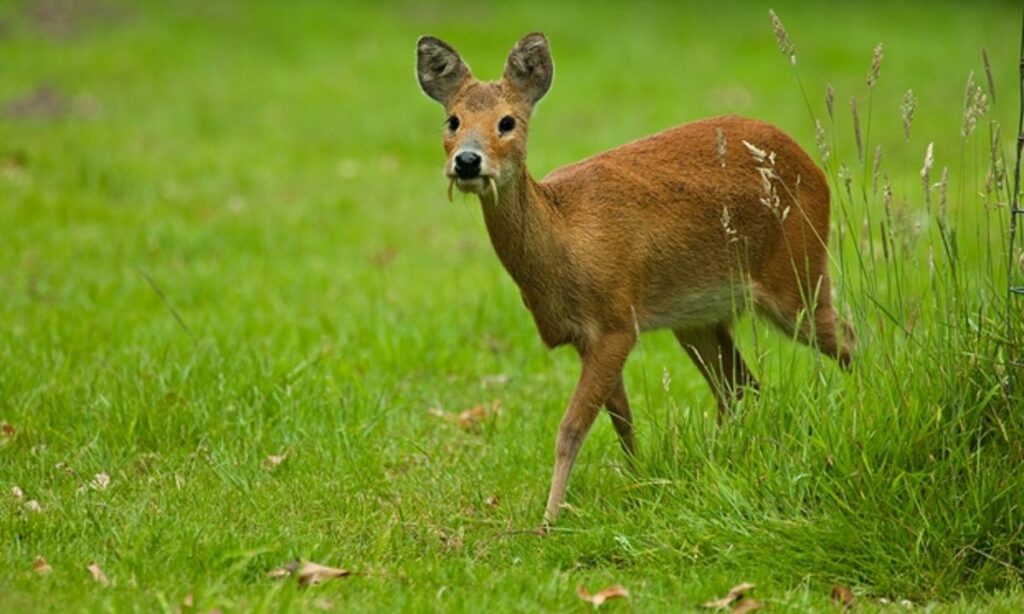The Chinese water deer, scientifically known as Hydropotes inermis, is an intriguing and distinctive species of deer that captivates with its prominent canine tusks. Native to China and Korea, this deer stands apart from others due to its physical characteristics and habitat preferences. In this comprehensive article, we will delve into the habitat, population, physical characteristics, feeding habits, environmental impact, conservation efforts, and cultural significance related to the Chinese water deer.
Physical Characteristics and Prominent Tusks
The Chinese water deer is relatively small in size compared to other deer species, measuring between 55 to 85 centimetres at the shoulder and weighing approximately 9 to 18 kilograms. What immediately draws attention are the elongated upper canines, or tusks, which protrude from the mouth of the males. These tusks, reaching lengths of up to 7 centimetres, serve as important features during mating season for display and fighting. Fascinatingly, female Chinese water deer also possess tusks, albeit much smaller in size. The tusks add to their unique and captivating appearance, making them easily identifiable in their natural habitats.

Habitat and Native Populations
Chinese water deer are well-adapted to a variety of habitats, including marshes, reed beds, riversides, and grasslands. They have evolved to live in wetland areas, displaying remarkable swimming abilities that earned them their common name. The availability of dense vegetation and water sources is crucial for their survival. Historically, Chinese water deer were primarily found in China and Korea, where they thrived in these wetland environments. The reed beds and marshes provided them with the necessary cover and food resources. However, due to their unique characteristics and aesthetic appeal, they have been introduced to several other countries, including the United Kingdom, where they are now considered a naturalised species.
Environmental Impact and Fragmented Populations
The introduction of Chinese water deer to countries like the United Kingdom has had both positive and negative environmental impacts. On the positive side, their presence has contributed to the diversity of wild deer species in the area. They bring a unique aspect to the ecosystem and provide researchers with an opportunity to study their behaviours and ecological interactions. However, concerns have also arisen regarding habitat fragmentation and competition with native populations. In the United Kingdom, the populations of Chinese water deer are currently fragmented and dispersed across different regions. This dispersal has led to fragmented habitats and potential challenges for maintaining healthy and sustainable populations.
Feeding Habits and Selective Feeders
Chinese water deer are known as selective feeders, exhibiting preferences for specific plant species. Their diet primarily consists of grasses, sedges, and reeds, though they can adapt their feeding habits based on seasonal variations and food availability. During winter months, when food sources are scarce, they may also browse on tree bark and shrubs. One of their remarkable adaptations is their powerful hind legs, which enable them to reach higher vegetation levels and access a diverse range of food options. This selective feeding behaviour allows them to optimise their energy intake and ensure their survival in their respective habitats.
Solitary Nature and Breeding
Chinese water deer are known for their solitary nature, typically living alone or in small family groups consisting of a female and her offspring. Males, in particular, are territorial animals and mark their boundaries using scent secretions. These scent markings serve as a means of communication and help establish dominance in their respective territories. Breeding season for Chinese water deer usually occurs between November and December, during which males compete for the attention of females. The males display their tusks prominently and engage in ritualised fights to establish dominance and secure mating opportunities. This behaviour highlights the importance of their tusks in reproductive success and ensures the continuation of their unique physical traits.
Population and Conservation Status
The population of Chinese water deer has experienced fluctuations over the years due to various factors, including habitat loss and hunting. Currently, the International Union for Conservation of Nature (IUCN) lists the Chinese water deer as “vulnerable.” Efforts are underway to protect their native habitats and manage their populations in areas where they have been introduced. Conservation organisations and wildlife management authorities are actively working to monitor population trends, mitigate threats, and implement sustainable management practices to ensure the long-term survival of this unique deer species. These efforts include habitat restoration, captive breeding programs, and public awareness campaigns to promote the conservation of the Chinese water deer.
Cultural Significance
Beyond their ecological and conservation significance, Chinese water deer also hold cultural value in certain regions. In Chinese folklore, the deer is often associated with longevity, good fortune, and spirituality. It is believed to possess mystical powers and is depicted in various forms of art, literature, and traditional celebrations. The presence of Chinese water deer in the cultural fabric of certain communities highlights their connection to human history and the significance of preserving their natural habitats.

Conclusion
The Chinese water deer, with its prominent tusks and habitat preferences, stands as a fascinating and distinct species within the diverse world of deer. Their ability to thrive in wetland environments, selective feeding habits, and solitary nature make them intriguing mammals to study. As efforts continue to conserve their native populations and manage their impact on non-native habitats, we can hope to preserve the beauty and diversity of this remarkable deer species for generations to come. By understanding and appreciating the Chinese water deer, we deepen our understanding of the natural world, its intricate ecosystems, and our responsibility to protect and conserve its precious inhabitants.
Additional Resources

Ash is a contributing author who has been writing about wildlife for as long as he can remember. He has a vast knowledge of many different types of animals, from the tiniest shrews to the great whales that live in the deepest oceans.
